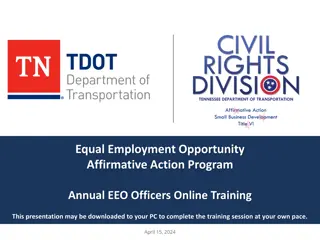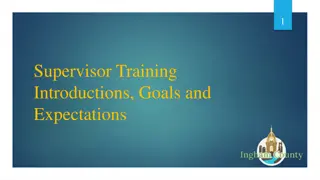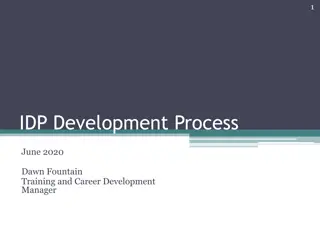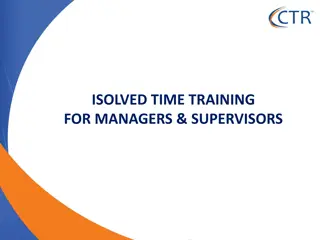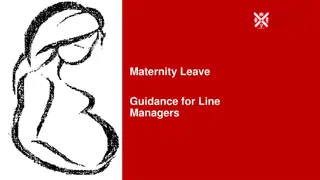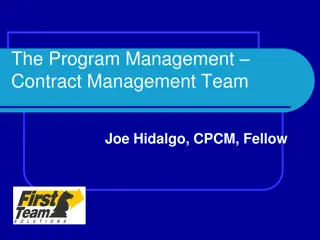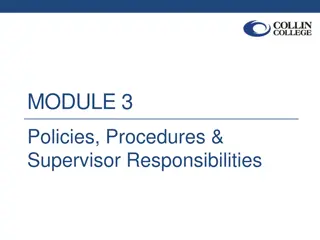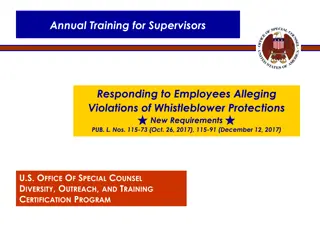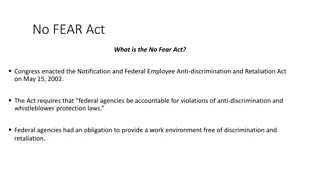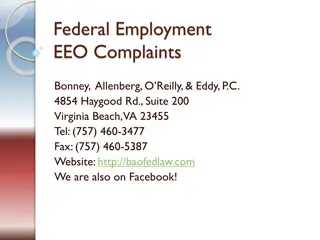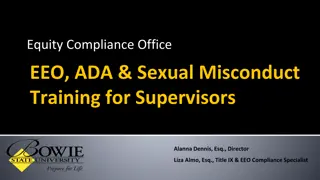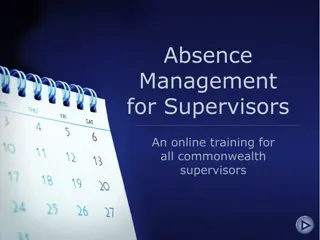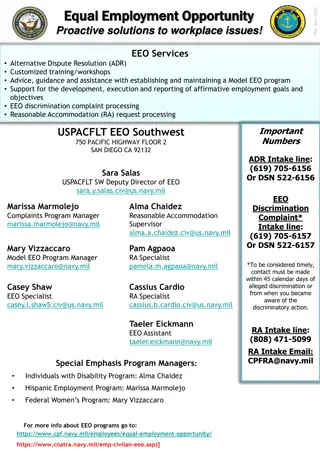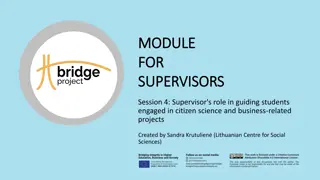Comprehensive EEO Training for Managers and Supervisors
Gain insights into Equal Employment Opportunity (EEO) responsibilities, program awareness, discrimination prevention strategies, and EEO benefits through facilitated training for managers and supervisors. Understand the significance of EEO laws and regulations to create an inclusive and discrimination-free workplace.
Download Presentation

Please find below an Image/Link to download the presentation.
The content on the website is provided AS IS for your information and personal use only. It may not be sold, licensed, or shared on other websites without obtaining consent from the author. Download presentation by click this link. If you encounter any issues during the download, it is possible that the publisher has removed the file from their server.
E N D
Presentation Transcript
Department of Budget & Management Office of Fair Practices Equal Employment Opportunity (EEO) Training Directors, Managers, and Supervisors Facilitated By: Created by: The Office of the Statewide EEO Coordinator 301 W. Preston Street, Room 607, Baltimore, MD 21201 Phone: 410-767-3800
Equal Employment Opportunity Is not something a manager or supervisor can afford to think about only when something goes wrong or someone complains. Nor is it something separate from your mainstream duties as a manager/supervisor. Lack of attention to this aspect of your manager/supervisor responsibilities can create difficulties for management, as well as, a disruption and expense for the agency. 11 1
EEO Self-Inventory Please take a few minutes to complete the EEO Self-Inventory Form 2
Objectives: Provide management with: Greater awareness of the State s EEO Program; A practical understanding of the responsibilities of managers/supervisors; Strategies to reduce discrimination in the workplace; Knowledge of the benefits of EEO. 3
Objective #1 Understanding the State EEO Program & the Forms Of Discrimination 4
Definitions Equal Employment Opportunity (EEO) is about ensuring that all employees have equal access to the opportunities that are available at work by: Making sure that the workplace is free from all forms of unlawful discrimination and harassment, and Providing programs to assist members of EEO protected groups to overcome past or present disadvantages. Some EEO strategies may include: workplace rules, policies, practices and behaviors (e.g. recruitment programs and access to training and career development). 5
EEOis theLAW Title VII of the Civil Rights Act of 1964 Civil Rights Act of 1991 Americans With Disabilities Act of 1990 Age Discrimination in Employment Act of 1967 Equal Pay Act of 1963 State Personnel and Pensions Article of the Annotated code of MD, 2-302 and Title 5, Subtitle 2 Executive Order 01.01.2007.16 Code of Fair Employment Practices State Article Title 20 6
EEO in the Workplace EEO ensures the every citizen receives a fair and impartial opportunity for State employment; EEO is about removing barriers so all state employees have the chance to perform to the best of their abilities; EEO is about maximizing the potential of DBM s diverse population; EEO is about valuing people and respecting their abilities, backgrounds and talents. 7
Workplace issues relevant to EEO Recruitment and retention Career development and promotion Work and family/caring responsibilities Flexible working arrangements (where permissible) Physical access Cultural awareness Workplace bullying and sexual harassment 8
Protected Groups Marital Status National Origin Race Religion Sex Sexual Orientation Age Ancestry Color Creed Disability Gender Identity/Expression Genetic Information 9
What is discrimination? Discrimination is different treatment or impact on the basis of a protected class. Discrimination includes selective, negative behavior toward a group or a member of that group based on assumptions or stereotypes about that group. Discrimination may also result from policies, practices, or behaviors that exclude otherwise qualified people from job opportunities. 10
Objective #2 A practical understanding of the responsibilities of Directors, Managers & Supervisors 11
Directors, Managers & Supervisors Roles & Responsibilities in the EEO Process Overall management s role in terms of EEO is to ensure the workplace is fair for all employees. Supervisors and managers are held responsible for ensuring the work environment is free of discrimination and harassment. The work atmosphere should provide employees with the opportunity to succeed and be fully productive. When an employee feels threatened by hostility in the office, he/she may not be able to perform at his/her highest potential. Practicing effective listening is a way of showing concern to subordinates, and it will foster cohesive bonds, commitment, and trust. Effective listening tends to reduce the frequency of interpersonal conflict and increases the likelihood that when conflicts emerge they can be quickly identified and addressed. 12
Directors, Managers & Supervisors Responsibilities in EEO Stay alert to potential areas of discrimination; Enforce the agency s EEO Program; Make early dispute resolutions an agency priority; Prevent retaliation; Set the Example model appropriate behavior; Educate employees on appropriate behavior and dispute resolution. 13
The Role of the Director, Manager & Supervisor in an EEO complaint is to Resolve problems/disagreements and other conflicts in the work environment as they arise. If management was aware of a workplace issue after a complaint was filed, the agency may become liable for not addressing and/or correcting the issue. Address concerns, whether perceived or real, raised by employees and follow-up with appropriate action to correct or eliminate tension in the workplace. 14
The Role of the Director, Manager & Supervisor an an EEO complaint continued Ensure that subordinate supervisors have appropriate managerial, communication and interpersonal skills to supervise most effectively in a workplace with diverse employees and to avoid disputes arising from ineffective communication. Educate employees about what behaviors are appropriate and inappropriate in the workplace and that inappropriate behavior may result in disciplinary action. 15
How Does the Complaint Process Work? An employee who feels s/he has been a victim of discrimination has options for pursuing a complaint. The employee may file a complaint with the agency, or through the EEOC or Maryland Commission on Civil Rights. A complaint filed with the agency must comply with the provisions of the State s Equal Employment Opportunity Program in the State Personnel and Pensions Article: must be filed in writing must be filed with the head of the principal unit or the EEO officer for the unit must be filed within 30 days after the employee knew or reasonably should have known of the alleged violation 16
How Does the Complaint Process Work? (cont.) After the complaint is received: - The agency Fair Practice and/or EEO officer shall investigate the complaint and make a recommendation to the head of the principal unit; - Within 30 days, the head of the principal unit or designee shall issue a written decision to the complainant, and may grant any appropriate relief; - The decision may be a dismissal of the complaint; - A decision may be appealed to the Office of the Statewide Equal Employment Opportunity Coordinator; - An appeal shall be in writing and filed within 10 days of the decision; - The Statewide Equal Employment Coordinator shall review the complaint and the agency decision, shall conduct any necessary investigation, and shall issue a final decision within 30 days. 17
What to Do When a Employee Files A Complaint Direct the employee who wishes to file a discrimination or harassment complaint to the Fair Practice and/or EEO Officer; Actively participate in the complaint process by cooperating with the both the Fair Practice and/or EEO Officer and other investigative authorities; Consider the benefits of the mediation process (if the parties wish to participate) to facilitate a resolution before a complaint is filed; Contact the EEO Officer or Fair Practices Officer to ask questions and to learn more about the EEO complaint procedures. 18
What to Do When Employee Files a Complaint Continue to provide instruction, direction and feedback to all employees on the complaint process. Be aware of how personnel actions may or may not impact a complaint. Prevent retaliation/reprisal against an employee because of his/her involvement in a protected EEO activity (filed complaint, testified in an EEO hearing, etc.). Allow the employee a reasonable amount of time to communicate with the EEO Officer or designee as applicable. 19
Objective #3 Strategies to reduce discrimination in the workplace 20
Steps to Reduce Discrimination Complaints Be consistent employees use uniformity to measure discrimination. Employees compare what happens to them with what happens to their coworkers. Inconsistent treatment may initiate a complaint. Laws, regulations, and policies should guide all personnel decisions. Familiarize yourself with DBM policies that provide guidance on how to comply with laws and regulations. Even application of these laws will lessen the agency s vulnerability to discrimination complaints. 1) 2) 21
Steps to Reduce Discrimination Complaints 3)Resolve Policy Vacuums - If no policy exists in a given area, work with appropriate parties to create one. Nothing starts a complaint more quickly than the absence of standards for decision-making. Explain What You Do Explain your decisions. Not providing an explanation or giving one that is contrary to the facts will often give rise to a complaint. 5)Use Job-Related Criteria To help avoid discrimination complaints, use job-related criteria for your personnel actions and decisions. Be prepared to give job-related reasons for any situation that you have handled differently in the past and for any deviation from standard procedure and practice. 4) 22
Steps to Reduce Discrimination Complaints continued Document Decisions Form a habit of documenting decisions and the reasoning behind them. This will greatly help you in explaining your decisions. 6) Address any biases We all have biases. They result from our values and feelings, as well as our environment and experiences. When those views relate to sex, race, religion, national origin, disability, etc., legal problems may result. 7) Resolve Problems Handle problems and disagreements when they arise. 8) 23
Steps to Reduce Discrimination Complaints continued Be Fair An unfair action by a supervisor against an employee may be found to be unlawful discrimination. 9) Supervise the Supervisor Higher level supervisors may be held accountable for the decisions and actions of their subordinate supervisors. 10) Police yourself - Recognize that while the intention 11) of your actions is important, the manner in which your actions are perceived is crucial. 24
S T R I VE S T R I VE T O T O 25
Objective #4 Knowledge of the Benefits of EEO 26
How EEO Benefits Your Department, the Agency and the State. Decreases interpersonal conflict among employees Improves customer service and public perception Increases productivity Increases creativity Improves organizational culture Improves employee morale Improves retention of employees Enhances recruitment of employees Decreases complaints 27
Objective #5 A GLIMPSE OF ACTIONS THAT CAN LEAD TO AN EEO COMPLAINT 28
Potential Actions Because discrimination is often subtle, and there is rarely a smoking gun, when determining whether a protected class (age, ancestry, color, creed, disability, gender identity/expression, etc.) played a role in the decision making requires examination of all of the surrounding facts and circumstances. Rarely will the presence or absence of a single piece of evidence be determinative. Sources of information can include witness statements, documents, direct observation and statistical evidence, such as EEO data. Please reference Handout #2 for examples. 29
EEO - Wrap Up & Making the Connection Remain current with EEO responsibilities Familiarize yourself with the laws and stay current with changes & amendments; Support & cooperate with the Office of Fair Practices and the Statewide EEO Coordinator s Office in performing their duties; Request & attend EEO trainings; Work closely with EEO staff on interpreting & implementing EEO requirements. Rely solely on job-related factors in managing employees. Maintain a harmonious work environment, free from discrimination. Acting promptly on any complaints of discrimination; Being open to questions about fairness in managing employees Emphasize your commitment to EEO to employees by words and actions. SET THE EXAMPLE!! 30




